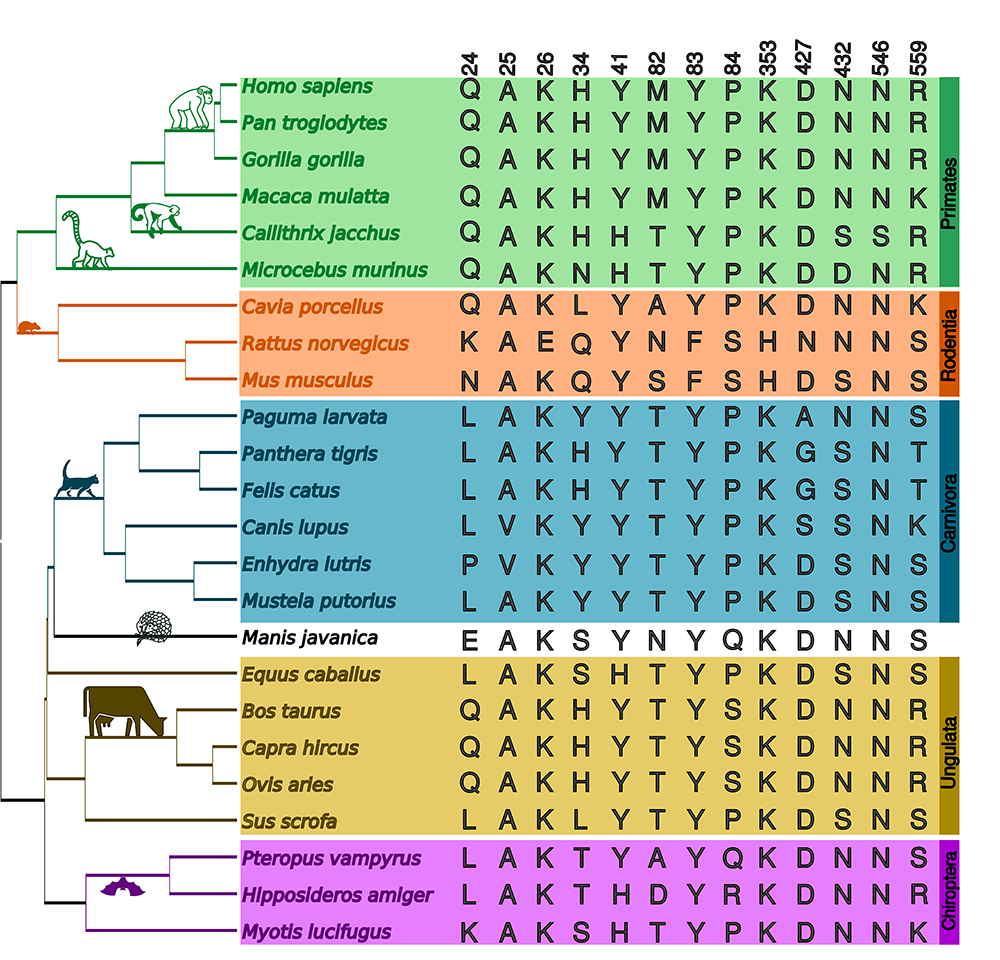By Maria Cátira Bortolini, Professor, Universidade Federal do Rio Grande do Sul, Department of Genetics, Human and Molecular Evolution Laboratory, Porto Alegre, RS, Brazil
The article “ACE2 diversity in placental mammals reveals the evolutionary strategy of SARS-CoV-2” published in Genetics and Molecular Biology (FAM, et al., 2020; vol. 43, no. 2), stresses that the viruses need the host cell to replicate. It is no different with SARS-CoV-2, responsible for the pandemic of the disease caused by it, COVID-19. SARS-CoV-2 originated from a bat coronavirus, and in the year 2019, the “jump” between the two species (bat; Rhinolophs affinis > human; Homo sapiens) happened. Random mutations and natural selection explain these jumps, which must be occurring since these species co-exist. In the past two decades, two events before SARS-CoV-2 are known: SARS-CoV was initially transmitted to humans by the palm civet (Paguma larvata) and MERS-CoV by the dromedary (Camelus dromedarius), but the impact of these infections was small when compared to COVID-19. In January 2020, researchers identified the ACE2 protein as the gateway to SARS-CoV-2 (Figure 1) in the human cell (XU et al., 2020). ACE2 modulates blood pressure, among other functions in the mammals.

Figure 1. Human ACE2 (blue) binding to SARS-CoV2 spike glycoprotein (gray). Modified from Fam et al., 2020.
From long experience with evolutionary studies with humans and other primates (see as examples, VARGAS-PINILLA et al., 2015; VISCARDI et al., 2018), I decided, together with current and former members of my team, to put aside, momentarily, our research projects in order to dedicate ourselves to the evolution of SARS-CoV-2, and its well-succeeded capacity to infect humans. Thus, we evaluated the differences in the ACE2 amino acid sequence of 70 mammal species (FAM et al., 2020). We also researched the variation of ACE2 in human populations using data from the 1000 Genome Project. The goal was to identify the ACE2 diversity pattern, and if it would be related to the infection for SARS-CoV-2.
We found a notable amino acid variation in 30 ACE2 sites that SARS-CoV-2 uses to bind and promote its entry into the host cell (Figure 2). The variation is so marked between these 70 species, that a classical Darwinian natural selection signal was detected, possibly related to the vital function of ACE2 in the mammals. On the other hand, there is no variation between human populations, considering these 30 sites. Our results indicate that other species, except apes, would not be easily infected by SARS-CoV-2, but all humans would be potentially susceptible to infection by SARS-CoV-2. Differences in the rate of infection and mortality in humans could be related to the innate immune responses, other unknown genetic factors, as well as non-biological factors.

Figure 2. Variable amino acid sequences of mammalian ACE2 in sites of interaction with SARS-CoV-2. The number of sites and species investigated were reduced in this illustration. Modified from Fam et al., 2020.
In summary, SARS-CoV-2 has high performance to infect Homo sapiens individuals, from any population, and has so far won the evolutionary arms race against us.
References
VARGAS-PINILLA, P., et al. Evolutionary pattern in the OXT-OXTR system in primates: coevolution and positive selection footprints. PNAS [online]. 2015, vol. 112, no. 1, pp. 88-93, e-ISSN: 1091-6490 [viewed 29 June 2020]. DOI: 10.1073/pnas.1419399112. Available from: https://www.pnas.org/content/112/1/88
VISCARDI, L.H., et al. Searching for ancient balanced polymorphisms shared between Neanderthals and Modern Humans. Genet. Mol. Biol. [online]. 2018, vol. 41, no. 1, pp. 67-81, ISSN: 1678-4685 [viewed 29 June 2020]. DOI: 10.1590/1678-4685-gmb-2017-0308. Available from: http://ref.scielo.org/nd2y9x
XU X., et al. Evolution of the novel coronavirus from the ongoing Wuhan outbreak and modeling of its spike protein for risk of human transmission. Sci China Life Sci [online]. 2020, vol. 63, no. 3, pp. 457-460, e-ISSN: 1869-1889 [viewed 29 June 2020]. DOI: 10.1007/s11427-020-1637-5. Available from: https://pubmed.ncbi.nlm.nih.gov/32009228/
To read the article, access it
FAM, B.S.O., et al. ACE2 diversity in placental mammals reveals the evolutionary strategy of SARS-CoV-2. Genet. Mol. Biol. [online]. 2020, vol. 43, no. 2, e20200104, ISSN: 1678-4685 [viewed 29 June 2020]. DOI: 10.1590/1678-4685-gmb-2020-0104. Available from: http://ref.scielo.org/ffjgdd
External links
Genetics and Molecular Biology – GMB: <http://www.scielo.br/gmb>
Como citar este post [ISO 690/2010]:

















Recent Comments